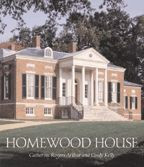
Reviews
Some of them stick in the minds of locals as place names, street names, or both - Belmont, Lansdowne, Stenton, Mount Pleasant. But they started as country houses, well-to-do Philadelphians' answer to English manor houses. You can read all about them and get a good look at them - inside and out - in this very handsome and informative book.
In this illuminating and handsomely illustrated volume, Mark Reinberger, a senior architectural historian, and Elizabeth McLean, an accomplished scholar of landscape history, examine the country houses that the urban gentry built on the outskirts of Philadelphia in response to both local and international economic forces, social imperatives, and fashion.
The Philadelphia Country House is the most complete study ever of the city’s colonial rural residences. It is likely to remain the definitive word on its subject in the pre-Revolutionary period in Philadelphia’s orbit for a long time to come. The volume has been years in the making, and the wealth and depth of information from archival sources and surviving sites that the authors have deployed here is prodigious. This well-illustrated volume includes current photographs complemented by numerous reproductions of historic images, as well as new analytical architectural drawings.
Colonial Americans did, of course, emulate English architecture and society, yet they created new forms suitable for life in America. Nowhere is the tension better seen than in the bourgeois estates built by wealthy Colonists on the fringes of Philadelphia. Many of these houses still stand, in landscapes that retain much of their history. Through them, we learn about American versions of the classics. In a new book, architectural historian Mark Reinberger and Elizabeth Mclean, an accomplished scholar of landscape history, examine these country houses that nevertheless exhibited city manners.
This scholarly achievement by Reinberger and McLean is a significant addition to American architecture studies... Recommended for specialists in American architecture and Philadelphia area studies and as a model of architectural and landscape scholarship.
Overall this important contribution will become the standard reference on the subject.
For the importance of its subject, the intelligence of its argument, and its visual quality, this is the best book on the architectural history of British colonial America.
Reinberger and McLean have succeeded in illuminating the nature and significance of a specific building type in colonial America, the country house or seat, focusing on those around the city of Philadelphia. The scholarship is extremely sound, the documentation is profuse, and the book effectively presents a tremendous amount of information on a significant topic that deserves elucidation. No comparable study exists.
Book Details
Acknowledgments
Note to Reader
Introduction
Part I
1. The Bourgeois Country House in England
The Changing Nature of the English Gentry
The Rearrangement of the House
Country House and Town House
The Compact
Acknowledgments
Note to Reader
Introduction
Part I
1. The Bourgeois Country House in England
The Changing Nature of the English Gentry
The Rearrangement of the House
Country House and Town House
The Compact House in the Seventeenth Century
Seventeenth-Century English Landscape and Gardens
The "Reform" of Eighteenth-Century English Architecture and Lands
2. The Bourgeois Country House in the Colonies
Colonial Architecture at Pennsylvania's Founding
The Later Colonial Bourgeois Country House
The Colonial Landscape
3. The Rise of the Philadelphia Country House
William Penn and the Country Life
The Lure of the Country in the First Generation, 1682–1722
Hiatus in the 1730s
4. Fulfillment in the Middle and Late Colonial Periods
A New Generation of Country Seats
The Proliferation of Country Seats in the 1740s and 1750s
The General Character and Use of Country Seats at Midcentury
The Flowering of the 1760s and Denouement in the 1770s
Part II
5. The Process of Design and Building
Design and Drawing
The Process of Building
Labor
Chapter
Elements of Landscape and Architecture
Landscape
Architectural Exteriors
Interiors
Framing
Urban and Rural
7. Organizing the Fabric
Proportion
Hierarchy
Room Use and Parade
8. The Logic of Service Spaces
Service Spaces
The Working Landscape and Agriculture
Part III
9. Diversity in the First Generation of Country Houses
William Penn's Pennsbury Manor
Fairhill
Belair
Fountain Low (Later Graeme Park)
10. Establishing an Architectural Norm
Stenton
The Progeny of Stenton, Especially Hope Lodge
11. The New Ideal of the Villa
Springettsbury
Bush Hill
Belmont
The New Ideal of Retirement
12. An Explosion and Variety of Country Houses at Midcentury
Woodford
The Jacob Marks House and Whitby Hall
Cedar Grove, The Cliffs, Grumblethorpe, Mount Airy, Bartram's House and Garden
Fountain Low to Graeme Park
13. The Flowering of the 1760s
Mount Pleasant
Port Royal
Cliveden
14. Denouement
Laurel Hill
Waln Grove
Summerseat
The Deshler-Morris House
The Thomas Mifflin House (with an Aside on Smith's Octagon)
Chalkley Hall
The Hills
Lansdowne
Conclusion
Appendix
Notes
Essay on Sources
Index







